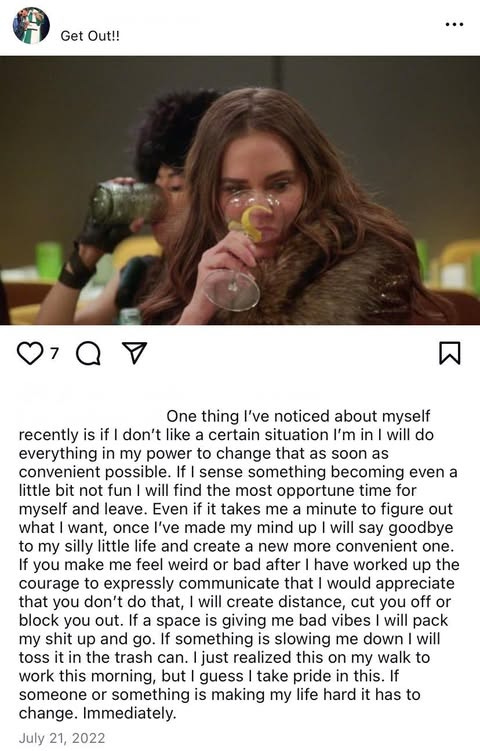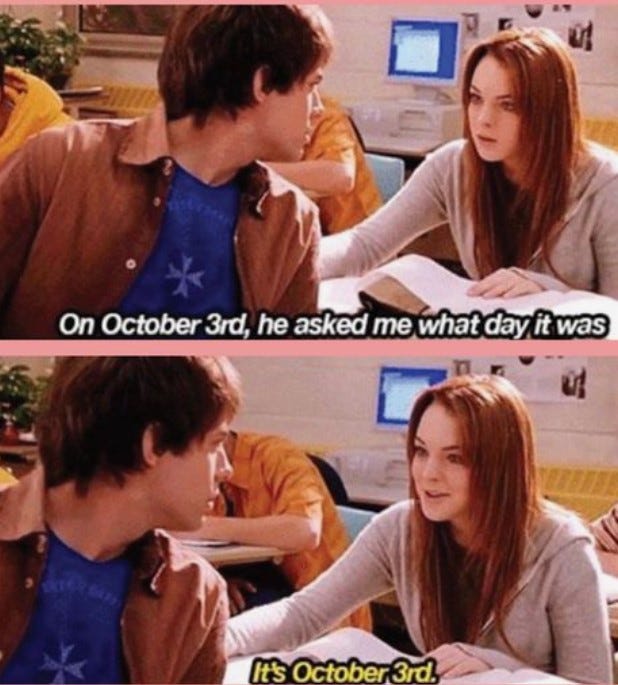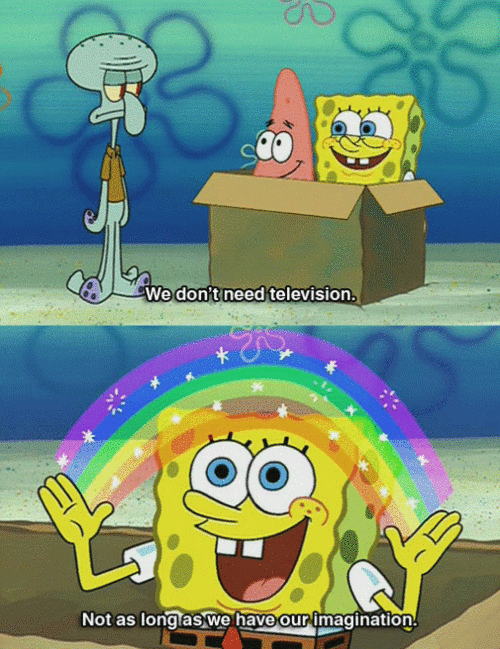Everything I’m Not Made Me Everything I Am
Attachment Theory Isn’t the Problem. How We Use It Is.
What is the best way to describe something? To convince someone that something is legitimate? To get someone to buy in? The most compelling, effective way is to create a narrative around it—to tell a story.
I can’t remember who said it, but I was listening to a critique of contemporary conservatism where the speaker described ideology as talking about everything it is not. Conservatives are obsessed with the identities they don’t want to be associated with. They are anti-trans, anti-Black, Asian, Hispanic, Indigenous, antisemitic, anti-women, anti-vaccine, anti-choice—the list goes on and on. They often try to dress these up as pros: pro-life, pro-traditional values, pro-freedom of speech, pro-gun, but the things they are in favor of are at the expense of others, uncaring of the harm they cause to anyone else1.
The conservative strategy is to over-index on shit that doesn’t matter. This is how we2 toddle around in a culture war while fascists take our rights away, creating new human rights to violate every other day.
Ask someone over the age of 45 what the function of feminism is and they probably could not tell you. They would likely tell you everything it is not: never shaving, spitting on men, being unpleasant to anyone who wasn’t at the public bra burning, overall, menaces to society in the name of the divine feminine. The same with Black Lives Matter, the same with BDS and Free Palestine. They don’t even have to be over a certain age; ask your friend who blocks out all news content from their algorithms, they’ll likely say the same, albeit maybe a bit more timidly, hoping they won’t be wokescolded.
But I’ve found the same phenomenon happening in left-leaning spaces too. What I mean specifically is that on the left, we also talk about what things are not—not necessarily to reinforce our own beliefs—but to combat and dispel misinformation. The left has developed its own form of negation, not to alienate, but to clarify. Online, progressive discourse frequently responds to misinformation not by constructing new narratives, but by dismantling false ones.
We casually become the foremost voices on the societal implications of whatever TikTok trend went viral that week. We listen to the Michael Hobbes podcast repertoire, we cite our sources, we hit our saturation points of knowledge about every topic under the sun so we can tie everything together with red string on a corkboard, Charlie Kelly style, just so we can say “actually, that is not correct.”
However, I don’t think we necessarily finish what we start out to do. Dismantling misinformation is not, in itself, clarification. If we spend too much time clarifying what something isn’t, we risk forgetting to say what it is.
I recently read an excellent piece on an excellent Substack by an excellent writer, Valerie of Club Reticent. In “you can just leave,” she frames the ease of leaving unsatisfactory situations as a strength afforded to avoidants.
If you don’t know, the term avoidant is part of the larger theory of attachment. Attachment theory is a psychological school of thought that posits that healthy emotional bonds are formed in childhood. Depending on childhood experiences, one can grow to be anxiously attached, avoidantly attached, securely attached, or a mix of both (commonly referred to as “fearful avoidant”).
My issue with Valerie’s piece isn’t the words she wrote; I related to all of it. My mom passed away when I was 15, and I didn’t learn about her illness until the final weeks of her life. I (the only and eldest daughter—if you’ve ever wondered what was worse than eldest daughter or kid with dead parent, if there was some secret, more annoying, more mentally ill third thing: Hi, nice to meet you) was left with my three brothers to work out what the hell just happened.
Much like Valerie, I don’t enjoy or feel the need to talk about this here on Substack. I feel extremely exposed even leaving this in the essay, but it’s in service of a larger point I’m trying to make—and like I said, us on the left are always foaming at the mouth to make a point.
That traumatic experience cemented my anxious attachment style. But you know what I’m also really good at? Leaving. If something isn’t working, I’m walking. I actually made a finsta post about it years ago.
In her piece, Valerie also makes it clear that leaving isn’t done out of malice or retribution—it’s simply a conclusion she comes to as an avoidant. Again, it’s not about what’s been written, but the framing. Does ease in leaving belong solely to one side of the spectrum?
I think the idea here is that for avoidants, leaving is easy—which means on the other side of the spectrum, where I sit, the implicit assumption can be made that leaving must be difficult. But attachment theory, at its best, resists this kind of determinism, it’s more complex. Further to that, leaving the situations she describes in her piece—situations that are dysfunctional or that she’s outgrown—is healthy, and more of a sign of a secure attachment than anything3.
In the last few years on social media, I’ve seen attachment theory go the way of some hybrid astrology/pop psychology trend. Personally, I was introduced to it by this article. I then bought a book. And later, a friend recommended a therapist’s YouTube channel.
My entry point into attachment was guided by mental health professionals who provided accessible avenues to learning more and getting further help. What I realized when I got on TikTok a year later and my algorithms swapped data, was that this is not how people were using attachment theory. Instead, there were videos of creators caricaturing different attachment styles and users in the comments of those videos writing screeds about attachment styles that weren’t theirs. Anxious people are clingy and needy, avoidants are sociopaths, fearful avoidants are narcissists.
A woman might recount a breakup in a 45-second TikTok video, and the comments would swarm with amateur diagnosis: “Major avoidant vibes.” “He’s got a dismissive attachment style, babe - run.” Actual mental health mechanisms were weaponized by content hungry clout chasers, eager to dominate the attention economy by abusing jargon and half read theory.
This hit a boiling point early last year, and the “intellectual” response was to refute attachment theory outright—only they were creating arguments from bad source material. For example, I listened to a podcast ranting about attachment theory. The host deemed it pseudoscience, claiming that people shouldn’t date based on their attachment style, but based on how that person makes them feel. This is essentially an argument in favor of secure attachment, but made with such allergy to terminology that it collapses into contradiction. Basically: you shouldn’t date based on your attachment style but you should date based on your attachment style.
Does anyone remember when Freya India wrote Substack pieces that weren’t riddled with conservative dog whistles? No? Me neither. But before I knew what her grift was, she wrote a piece on attachment that I really agreed with. She acknowledges that attachment theory is real, that if you are struggling with attachment you should seek help, and that there’s nothing wrong with being attached.
But again, the conclusion falls short. India urges readers to live life leading with your gut feelings, to not ruminate, to advocate for yourself, to not analyze as much. But if we’re talking about what attachment really is instead of what it’s not, that conclusion would be redundant.
I’ve already talked about this in a different post, but my dating life was less than optimal for a person who wanted to be in a relationship. I knew what I didn’t want and for the most part found it easy to move on when I knew for sure that someone wasn’t right for me. The only time I found it difficult was from a certain situationship4, which became the catalyst for me even getting into attachment theory.
I knew that I wanted to leave, but this was the first time that I didn’t know how. My gut feelings were clouded by future uncertainty: this person’s words almost never matched up with their actions, even though they reassured me time and time again of their shared intense feelings. I would sit in bed for hours ruminating over it, and I didn’t know how to advocate for myself. Instead of working out an exit plan, I was overanalyzing every small detail—even the ones that didn’t exist.
I diabolically but righteously cut the guy I was seeing before him out of my life so quickly I think it gave him whiplash (at least based on the unanswered text messages he sent). So why was this situation so difficult? I couldn’t figure it out until I got into attachment theory. I learned how trauma shaped my attachment style. I was given the tools to navigate the specific situations I kept finding myself in because those are the specific situations that many anxiously attached people find themselves in.
It took a while (a long while), but I finally got over it.
I started dating because I wanted to be in a relationship—something I’d never done before. Attachment theory helped me date strategically and effectively. I wasn’t wasting my time on forums as India writes, and I didn’t need to go to church as she insinuates in her piece. I applied attachment theory and stopped wasting my time on men who were either avoidant, disinterested but too cowardly to say, or both.
The reason I could stop wasting my time and go with my gut, advocate for myself, and find the healthy and secure relationship I’m in now is because I spent so much time working on my attachment—sometimes in therapy but largely on my own. I learned to change my behavior, stop excusing others’, and date with discernment. I stopped operating from a place of fear and started operating from a place of understanding and acceptance.
I did a lot of work to become secure and find a secure relationship, but I do still have anxious tendencies even in said relationship. When my boyfriend doesn’t text back quickly, I will think that something’s gravely wrong. When my friends don’t text back right away I think they’re angry with me. At the beginning of our relationship, my boyfriend kept reaffirming how much he enjoyed spending time with me, which naturally meant I was waiting for the other shoe to drop—for him to disappear into the abyss for whatever reason, be it personal feelings or circumstances outwith either of our control.
But my immediate thoughts after those terrible ones will be that none of that is true—and even if it was, it was okay. People are busy with their own lives, if something needs to be communicated with anyone in my life, we can work through it together. If things don’t work out in any of my relationships, that’s okay, I can form new ones. And if there’s a reason I need to or just want to leave, then I can and I will.
My anxious attachment style is a part of who I am, but it’s far from everything. There’s a faction of the internet who misuse and abuse categorizations from a variety of psychological theories and personality indicators for internet engagement.
They clamp down on your astrology sign, your Myers-Briggs type, your attachment style, Enneagram, colors—the list goes on. They put you in a box, marked up with labels and strict instructions on how you should behave and the expectations you should have of others. Viewers will take the bait and clamp down harder. Then “intellectuals” will come behind them, well-actually-ing and shitting all over whatever discourse is taking place.
The problem is those indicators can be helpful to people when they aren’t being used for internet clout, but by that point, baby and bath water has already been yeeted out the window.
If we spend so much time talking about what something isn’t instead of what it is, it can be easy to forget what it actually is.
When I crawled my way out of the hole that was my anxious attachment style like I was Beatrix Kiddo in Kill Bill Vol. 2, the effects spilled into other aspects of my life and almost everything got so much better: my job, relationships with family, my relationship with myself. I had no problem leaving situations that didn’t serve me, but I did have problems with self-esteem, boundaries, self-advocacy, and indecisiveness.
Had I discovered attachment on TikTok or Twitter, I’d probably be even more mentally ill than I was before—either because I was so entrenched in the hell of my own attachment style or because I had written it off as pseudoscience nonsense.
Categorizing my personality has always helped me organize and reflect with the most clarity. The Myers-Briggs test helped me navigate home and school life. The Insights Discovery Test helped me navigate work. Attachment theory helped me navigate my love life. I’ve even used Love Languages to communicate effectively.
These tests are far from the only thing I identify myself by, but they’ve helped me dodge anxiety attacks and navigate relationships. I also like learning things about myself in quaint and quirky little ways. Can a bitch not have a moment of eccentricity??? Like damn, what the fuck is wrong with a little whimsy????
I don’t think we should ever be so afraid to put ourselves in boxes that we refuse the possibility to learn more deeply about ourselves. It’s not the box that confines us—it’s how—and who—is telling us to remain inside it.
And if we dismantle every framework, every theory, every tool, without constructing something in their place, we don’t liberate ourselves from misunderstanding—we guarantee it. When we know only what something is not, we become vulnerable to narratives constructed by others. Control fills the space of genuine understanding.
If you’ve been buying into the refutation of pseudoscience and anti-intellectualism, good—but ask yourself: what are you replacing that with? If something has been disproven but no truth has been replaced in its stead, I think we should question that.
If we spend so much time describing what something isn’t but never what it actually is, we become susceptible to even deeper misunderstanding.
The task, then, isn’t to abandon the story outright. It is to tell it ourselves, honestly, thoughtfully, and in full.
If you think I’m talking about Americans here, I am, but this isn’t exclusive to them. Do you know how many Tories I’ve heard go on and on about their freedom of speech? Many Europeans refuse to admit their conservatism is a disease not unlike the American kind: disgusting, arrogant, uneducated, anti-intellectual, and inherently white supremacist.
i.e., western society
Maybe Valerie does have an avoidant attachment style, which, among other things, might involve being unable to trust people, avoiding conflict at all costs, rarely sharing your feelings with people, and a paralyzing fear of rejection, but I didn’t pick up on those things in her piece.
a word I HATE. Embarrassing that I must now use it in my own writing. Even more embarrassing that I was in one!










To answer or the answer with another question your initial question “what is the best way to describe something?” Is essentially the same thing when we settle for explaining what we don’t want or don’t need or know. Instead of saying what we do want, need or know. Yk what I mean? Do we save time to explain ourselves by saying what we don’t want instead of what we do. Because it’s the easiest way or bc it’s a glass half empty analogy? Idk, I always think about that often.